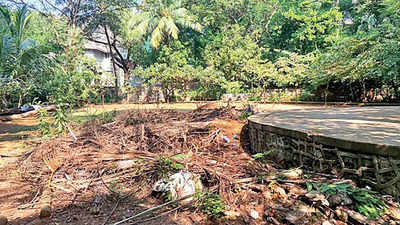
How this woman architect made a room for herself in Mumbai
Sharmila Ganesan Ram / TNN / Oct 3, 2021, 12:03 IST
Perin Mistri (extreme right) standing with the family members
Built for a Parsi notable named Sir Behramji Karanjia, Shengre-La--an Art Deco-style ground-plus-twostorey bungalow with wide verandahs and long balconies--is the first major work and one of few surviving imprints of the blue-eyed, hockey-gardening-and-snakesloving Perin, who is believed to be India's first qualified woman architect. Her other enduring fingerprint in Mumbai is Malabar Hill's St Stephen's Roman Catholic Church--a white, concave tower that holds a huge red crucifix within its recesses.
"Her personality translated itself into her signature," says Perin's niece Tina Sutaria about her "stunning" aunt who joined the family's construction business in 1937 and practised for almost half a century before she died in 1989. "She was non-fussy, practical and straightforward," says Tina about Perin who designed the Khatau mills in Borivali, several health centres for the Salvation Army in Byculla and an extension to the Bombay Scottish School in Mahim besides a floor of the CST office building of this newspaper.
The Mistris had been in the real estate business for four generations before Perin was born in 1913. With buildings spanning from Calcutta to Ceylon, the Navsari-based builders were considered experts in the construction of textile mills. After moving to Mumbai, their firm--Ditchburn, Mistri and Bhedwar--built the Colaba and Cuffe Parade Sea walls, the Taraporevala Mansion at Cuffe Parade and the first runway of the Mumbai Airport. Once, as their car passed by Sir JJ College of Architecture, her father had asked Perin: "Would you like to do architecture?" "I'd love to," she replied.
"Mumbai,
which was very conservative then, never accepted women to be fit for
professional work but she, because of her probing and magnetic
personality, never had the problem of securing jobs," says Perin's son
Dosu Bhiwandiwalla.
Perin joined Sir JJ School of Architecture after completing her schooling in England. At JJ, Perin is believed to have argued during a debate: "If men were compelled to do housekeeping, they would realise how avoiding cornices, carved ornament and other dust-traps was an advance."
Housekeeping for Perin, whose marriage to businessman Ardeshir Bhiwandiwalla had brought her to their family bungalow in Bandra, also meant avoiding reptiles.
"Pali Hill was a jungle then. The family's wooden house had snakes in its basement. But she didn't kill them. Instead, she decided to study snakes at Bombay's Haffkine's Institute because she knew that most snakes were not poisonous," says Dosu, who also recalls his mother climbing the dome of Metro Cinema in her 60s, when the theatre was undergoing repairs. She worked with steel and cement all day, the piano-loving, "very-English-in-her-manners" Perin--who was once invited over by the Queen of England for tea--tended to favour dainty clothes and understated strings of pearls around her neck during the many musical evenings she hosted. In the early 70s, Perin even founded the first Indian Soroptimist Club in Bombay. Before that, a whim to pursue farming saw her buying a plot in Karjat which she would trudge up to on weekends in gumboots.
Ditchburn, Mistri and Bhedwar closed down in 1993 a few years after Perin's death at age 75. Tina--who is now trying to digitize the company archive that includes some of Perin's "beautiful" renderings on Irish linen--concedes that her true inheritance is the architect's fierce persona. "She never accepted no for an answer," says Tina, harking back to the time her aunt went up to the office building of a car company, asked to see the managing director and requested him to make a customised jeep that would be high enough for the water in her Karjat farm not to get in. "He explained to her that he could not make just one car for her," says Tina.
“No prizes for guessing the outcome of that meeting."
Perin joined Sir JJ School of Architecture after completing her schooling in England. At JJ, Perin is believed to have argued during a debate: "If men were compelled to do housekeeping, they would realise how avoiding cornices, carved ornament and other dust-traps was an advance."
Housekeeping for Perin, whose marriage to businessman Ardeshir Bhiwandiwalla had brought her to their family bungalow in Bandra, also meant avoiding reptiles.
"Pali Hill was a jungle then. The family's wooden house had snakes in its basement. But she didn't kill them. Instead, she decided to study snakes at Bombay's Haffkine's Institute because she knew that most snakes were not poisonous," says Dosu, who also recalls his mother climbing the dome of Metro Cinema in her 60s, when the theatre was undergoing repairs. She worked with steel and cement all day, the piano-loving, "very-English-in-her-manners" Perin--who was once invited over by the Queen of England for tea--tended to favour dainty clothes and understated strings of pearls around her neck during the many musical evenings she hosted. In the early 70s, Perin even founded the first Indian Soroptimist Club in Bombay. Before that, a whim to pursue farming saw her buying a plot in Karjat which she would trudge up to on weekends in gumboots.
Ditchburn, Mistri and Bhedwar closed down in 1993 a few years after Perin's death at age 75. Tina--who is now trying to digitize the company archive that includes some of Perin's "beautiful" renderings on Irish linen--concedes that her true inheritance is the architect's fierce persona. "She never accepted no for an answer," says Tina, harking back to the time her aunt went up to the office building of a car company, asked to see the managing director and requested him to make a customised jeep that would be high enough for the water in her Karjat farm not to get in. "He explained to her that he could not make just one car for her," says Tina.
“No prizes for guessing the outcome of that meeting."
FacebookTwitterLinkedinEMa